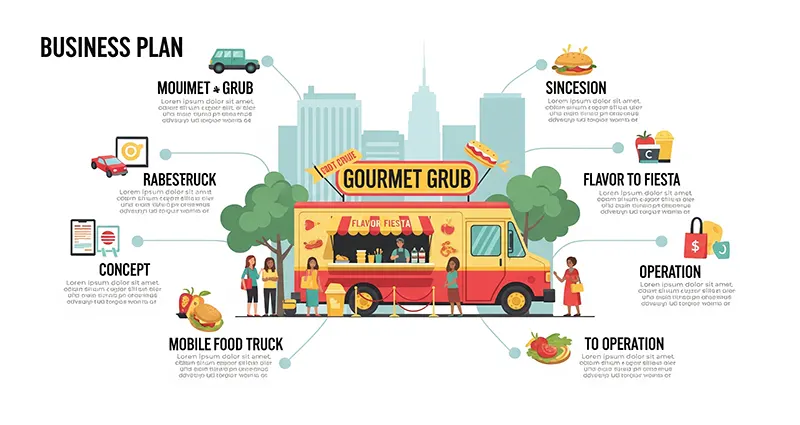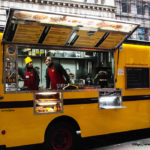Starting a food truck is a dream for many aspiring entrepreneurs—it offers the creative freedom of a restaurant without the immense overhead of a brick-and-mortar location. However, a passion for food is only part of the recipe for success. A well-structured business plan is the blueprint that will guide you from a great idea to a thriving mobile eatery. This template outlines the key components you need to research, plan, and present to potential investors or lenders.
[Your Food Truck Name] Business Plan
1. Executive Summary
- Business Concept: Briefly describe your food truck, your menu, and your unique selling proposition (USP). What kind of food will you serve? What sets you apart from the competition?
- Mission Statement: A short, powerful statement that defines your purpose and values.
- Financial Highlights: A snapshot of your key financial projections, including start-up costs, projected revenue for the first one to three years, and your funding request.
2. Company Description
- Legal Structure: Will you be a sole proprietorship, LLC, or S-Corp?
- Vision: What is your long-term vision for the business? Do you plan to expand to a fleet of trucks, open a commissary kitchen, or launch a line of retail products?
- Business Goals: Specific, measurable goals for the first year (e.g., “Secure 3-5 recurring weekly locations,” “Achieve a profit margin of 20% by Q4”).
3. The Market Analysis
- Industry Overview: Provide an overview of the food truck industry, including market size, growth trends, and consumer demographics in your target area.
- Target Market: Who are your ideal customers? Define them by location (e.g., downtown office workers, university students), demographics (e.g., age, income), and behavior (e.g., frequent food truck users, event attendees).
- Competitive Analysis: Who are your competitors? Research other food trucks, local restaurants, and even catering services. For each competitor, analyze:
- Their strengths and weaknesses.
- Their pricing and menu.
- Their online presence and customer reviews.
- Their typical operating locations.
- SWOT Analysis: Summarize your internal Strengths and Weaknesses, and external Opportunities and Threats.
4. Menu and Service Offering
- Menu Items: List your core menu items with a brief description and pricing. Be sure to highlight your signature dishes.
- Pricing Strategy: Explain how you determined your prices. Will you use a cost-plus pricing model or a market-based strategy?
- Sourcing: Where will you get your ingredients? Mention your suppliers and whether you will use local, organic, or specialty ingredients.
- Service Model: Describe the customer experience, from ordering to payment. Will you accept cash, card, and mobile payments?
5. Marketing and Sales Strategy
- Branding: Describe your food truck’s name, logo, and overall brand aesthetic. How will you communicate your brand story to customers?
- Marketing Funnel: How will you attract, engage, and retain customers?
- Digital Marketing:
- Social Media: Which platforms will you use (Instagram, Facebook, Twitter)? What kind of content will you post?
- Website/Online Ordering: Will you have a website? Will you use a service like StreetFoodFinder.com to post your location?
- Online Reviews: How will you encourage and manage online reviews on platforms like Yelp, Google, and TripAdvisor?
- Local Marketing:
- Location Strategy: Where will you park? Will you focus on business districts, festivals, or private events?
- Strategic Partnerships: How will you partner with other businesses, breweries, or event planners?
- Promotions: Will you offer loyalty programs, happy hour specials, or a “deal of the day” to attract customers?
6. Management and Operations
- Management Team: Who will run the business? Provide a brief bio for key team members, highlighting relevant experience.
- Staffing Plan: How many employees will you hire? Describe the roles (e.g., head chef, cashier, line cook) and the training process.
- Truck and Equipment:
- Vehicle: What type of truck will you acquire? (e.g., a used step van, a new custom-built trailer).
- Kitchen Equipment: List all the essential equipment you will need (e.g., grill, fryer, refrigerators, POS system).
- Operating Plan:
- Operating Hours: When will you be open for business?
- Commissary Kitchen: Where will you prepare and store your food?
- Supply Chain: Describe your process for ordering, receiving, and storing inventory.
- Licenses and Regulations: List all required licenses, permits, and health certifications you will need to operate legally in your area.
7. Financial Plan
- Startup Costs: Create a detailed list of all one-time expenses required to get started, including the truck purchase, equipment, licenses, initial inventory, and marketing materials.
- Funding Request: How much money are you asking for, and what will you use it for?
- Financial Projections:
- Break-Even Analysis: At what point will your revenue equal your costs?
- Projected Income Statement: A month-by-month projection of your revenue, cost of goods sold, and operating expenses for the first two years.
- Projected Cash Flow Statement: A month-by-month projection of cash coming in and out of the business, crucial for managing liquidity.
- Projected Balance Sheet: A summary of your assets, liabilities, and equity.
- Exit Strategy: What is your long-term plan for the business? Will you sell it, pass it on, or expand it?
A comprehensive business plan is your first step toward proving that your food truck is not just a passion project, but a viable, profitable business. It forces you to think through every detail, anticipate potential problems, and prepare a roadmap for success on the road.










